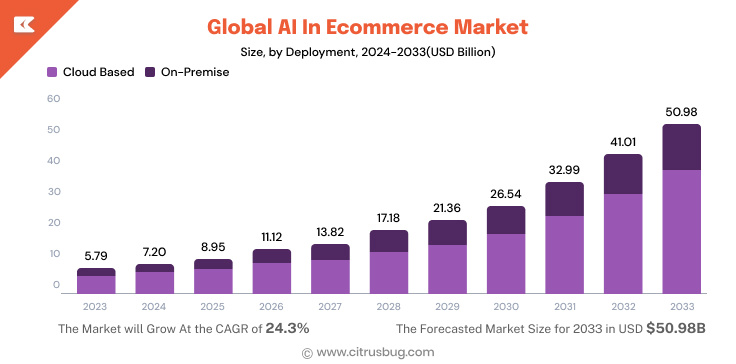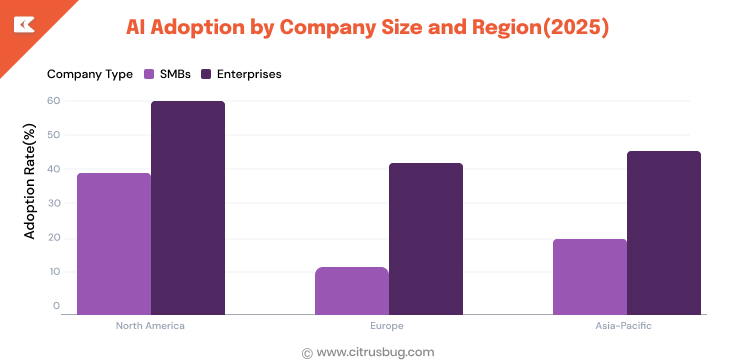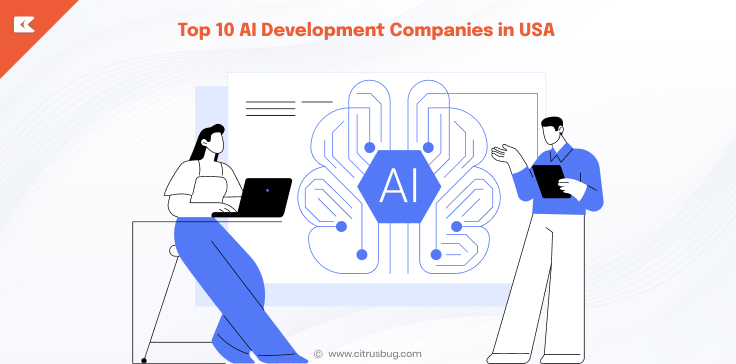AI in Ecommerce Statistics 2025: Adoption Rates, Market Insights, and Future Trends
- November 11, 2025
-
432 Views
- by Ishan Vyas
Table of Contents
- Introduction
- The Rise of AI in Ecommerce
- Key AI in Ecommerce Statistics (2025 Snapshot)
- Adoption Rates: How Businesses Are Using AI
- Market Insights: AI’s Impact on Ecommerce Operations
- Future Trends Shaping AI in Ecommerce (2025 and Beyond)
- What These Trends Mean for Planning
- Opportunities for Ecommerce Businesses and Developers
- Conclusion
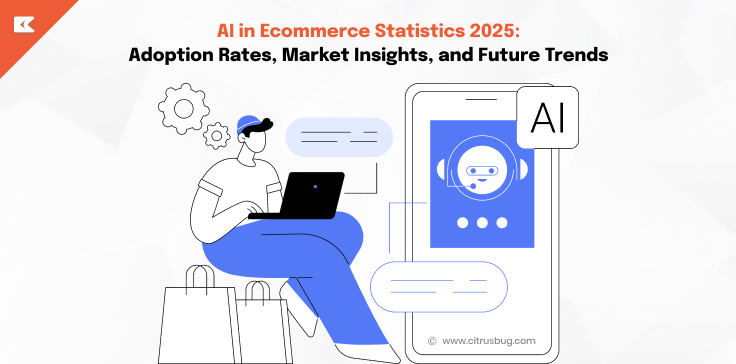
Introduction
AI is transforming ecommerce into data-to-decision, in real time. Online shopping is quicker and more efficient as retailers are now using machine learning to recommend products, chat support, and price automation. The AI in Ecommerce Statistics reports a great shift towards data-based personalization and predictive analytics, where manual guesswork is replaced with accuracy, which is done by machines.
This article shows the present situation in the field of AI in ecommerce, adoption levels, the major industry participants, and the new trends which are influencing the functioning of the digital stores in 2025. You also will have the application of AI use cases in ecommerce by businesses to enhance conversions, operations, and future growth.
The Rise of AI in Ecommerce
The initial AIs in the field of ecommerce were product recommendations, chatbots, and automatic pricing, which were uncomplicated tools.
These primitive systems tried to ensure that customers got to find products through the system quicker and that the burden of online sellers was relieved.
With time, these tools have developed into the complete AI ecosystem that currently drives marketing, logistics and customer experience.
The majority of retailers currently have one or more AI-based features in their online shops.
According to recent AI in Ecommerce Statistics, the Global AI in Ecommerce Market size is expected to be worth around USD 50.98 Billion by 2033, from USD 5.79 Billion in 2023, growing at a CAGR of 24.3% during the forecast period from 2024 to 2033.
Such a consistent increase is one of the indicators of a clear direction: ecommerce brands invest in automation, personalization, and predictive analytics to remain competitive.
The major forces that have contributed to this increase are:
- Greater customer experience by personalization.
- Automation increases operational efficiency.
- Smart decisions with real time data analytics.
To support these goals, many businesses are turning to custom ecommerce software solutions that embed AI directly into their platforms for smoother performance and scalability.
Key AI in Ecommerce Statistics (2025 Snapshot)
This is a factual overview of key AI in ecommerce statistics in 2025. These are the current adoption, ROI, customer impact, and market investment trends.
Core Statistics
AI Adoption Rate Among Ecommerce Businesses
- 89% of companies are either actively using AI or testing it via pilot programs.
- 77% of ecommerce respondents report using AI on a daily basis as part of their day-to-day operations.
- 84% of ecommerce companies report AI is a top strategic priority.
- In the U.S. B2B ecommerce sector, 33% of companies have full implementations of AI, while 47% are considering implementing AI.
ROI / Marketing & Personalization Gains
- AI-driven personalization can increase conversion rates by up to 15%, per industry research.
- Businesses leveraging and creating AI product recommendations are seeing increases in sales, with 43% of ecommerce businesses reporting this as a key benefit.
- Personalized AI email campaigns can see 40% higher open rates, according to some data.
Customer Engagement, Speed, and Conversion
- AI-powered chat boosts conversion: 12.3% of shoppers who interact with AI chatbots make a purchase vs. 3.1% who do not, a 4× increase.
- Customers supported by AI complete purchases 47% faster, thanks to accelerated decision-making and smoother interactions.
- Customers who return, tend to spend on average 25% more when they interact with AI powered tools such as recommendation engines.
Market Growth & Investment
- The AI in the ecommerce market is expected to reach around USD 8.65 billion by 2025.
- 93% of retailers have indicated they will increase spending on AI in the short term, implying a high level of confidence in AI’s ROI.
- In operations, AI implementations are already advanced in customer-facing areas: a survey found 59% of ecommerce respondents describe their AI setup as “very advanced.”
Adoption Rates: How Businesses Are Using AI
This is a summary of how different groups of ecommerce companies are adopting AI, as well as other important trends occurring in certain regions, and whether those trends support their AI adoption or holding it back.
Adoption by Company Size
- SMBs vs Enterprises
- In 2025, SMBs are rapidly adopting AI: in the U.S., SMB adoption rose from 14% to 39%, and is projected to reach 55% by 2025.
- In contrast, large enterprises have broader AI deployment: 41.2% of large EU enterprises used AI in 2024, versus just 11.2% of small firms.
- Larger companies tend to implement AI in more functions (IT, security, operations), while SMBs often focus on customer-facing areas like marketing and service.
- By mid-2025, enterprises are more likely to use it at scale than SMBs, who appear to be catching up, but remain more hesitant in cost and level of AI usage to scale.
- Barriers for SMBs
- A key challenge for smaller businesses is cost — many SMBs cite limited budgets as a big barrier to more aggressive AI adoption.
- Skill gaps are also significant: in the Asia-Pacific region, less than 10% of SMBs in 2024 had employees with AI engineering experience.
Adoption by Ecommerce Segment
- According to AI in Ecommerce statistics, customer engagement and marketing agents held 38% market share in 2024, showing that AI in ecommerce is especially common in marketing-driven roles.
- The same report forecasts a 33.4% CAGR for grocery and convenience retail in using agentic AI through 2030, indicating strong growth in that segment.
- This suggests that while fashion and electronics merchants are active in AI, grocery and convenience stores are emerging as significant adopters, likely driven by automated agents (e.g., chat, recommendation) tied to recurring purchases.
Adoption by Geography
North America
- North America is a major player in retail AI, holding a sizable portion of the AI in the retail market as of 2024.
- North America will continue to be a dominant region, with over 32% of the AI in retail market share in 2025.
Asia-Pacific
- The AI in the ecommerce industry in the Asia-Pacific region is expanding significantly, with the industry projected to see a CAGR of 21.2% for the region during its forecast period from 2025 to 2033.
- In addition, an APAC-focused SMB report notes that AI engineering skills remain more scarce in smaller companies in this region, slowing some adoption.
Europe
- Big Sur AI indicates that in Europe, 41.2% of large enterprises are using AI, while SMB adoption is much lower (11.2%), pointing to a gap in deployment by company size.
- On a broader market level, Europe is a growing region for AI in retail, though it lags North America in total dollar investment.
Market Insights: AI’s Impact on Ecommerce Operations
Here’s a look at how real-world ecommerce businesses are using AI in their operations, and the measurable impact.
Personalized Product Recommendations
- AI-enabled recommendation engines are generating strong business value for retailers. Machine-learning–based personalization can increase revenue between 10–15% for digitally native retailers.
- According to AI in Ecommerce statistics, companies leveraging AI to activate and coordinate personalized touchpoints have reported revenue improvements of 5–8% and reduced cost to serve by up to 30%.
- AI product suggestions account for 35% of Amazon’s revenue, and personalized recommendations enhance conversion by an average of 10–15%.
- Customers who engage with Amazon’s recommendations spend 29% more per session and show 73% higher customer lifetime value compared to those who don’t.
These insights show that personalization isn’t just a “nice-to-have”: it’s becoming a core operational tool that boosts both conversion and long-term customer value.
AI-Powered Chatbots and Virtual Assistants
- The use of AI to provide the “next best experience” led to a study by McKinsey suggesting company customer satisfaction ratings improved 15–20% when AI predicts and preemptively responds to a customer.
- Retailers are embedding conversational AI across support and sales, providing scalability across a 24/7 service so humans can work on the higher cognitive, higher-value tasks.
This demonstrates that AI-powered chat is not only enhancing CX, but streamlining and improving support operations overall.
Demand Forecasting & Inventory Management
- AI-based forecasting systems help ecommerce firms predict demand more accurately and optimize stock levels. AI demand-forecasting can improve inventory accuracy by about 35% and lower logistics costs by 15%.
- With improved forecasting, the risk of understocking is reduced, and the risk of overstocking is eliminated, with benefits to the retailer’s ability to operate profitably and serve customers.
These benefits make AI a key lever for operational resilience in fast-moving ecommerce environments.
Future Trends Shaping AI in Ecommerce (2025 and Beyond)
AI is moving from standalone features to systems dealing with some of the shopping experience in its entirety. Below are the main transitions to observe, with projected data points and sources.
Generative AI for Product Descriptions and AD Creatives
- What’s changing: Generative models are now being used for writing product copy, creating ad variants, and generating localized creative at scale. It will speed up catalog assembly and reduce time to market for campaigns.
- Forecast / data point:Generative AI will change a large share of retail working hours, their analysis documents that up to 50% of retail working hours are at risk of change (automation or augmentation) by generative AI.
- Practical impact: Teams can produce more ad variations and faster A/B testing, but will need to implement review gates for brand voice and accuracy.
AI Agents Managing end-to-end Customer Journeys
- What’s changing: “Agentic” or autonomous shopping agents will increasingly handle tasks such as discovery, comparison, checkout, and reorders on behalf of customers. These agents can act across brands and payment systems.
- Forecast / data point: AI agents statistics indicate that there will be increased rates of adoption of agent-based AI in enterprise software, one referenced forecast suggests a rapid jump towards agent-enabled enterprise applications in the next several years.
- Early evidence: recent trend reports show agentic features already account for measurable shares of active AI integrations in ecommerce (product recommendations, inventory agents, and shopping assistants). For example, Quid’s 2025 ecommerce trend analysis highlights product recommendations (15%), inventory management (10%), and AI agents (10%) as common active themes.
Integration of AI with AR/VR for Immersive Shopping
- What’s changing: AR and VR combined with AI let shoppers visualize products in context (try-on, in-room placement) while AI personalizes what is shown. This reduces uncertainty and return rates.
- Forecast / data point: industry forecasts put the AR retail market in the multi-billion dollar range by the mid-2020s; Grand View Research and related reports estimate AR retail applications to reach the low- to mid-$10 billions area by 2026, and Statista surveys indicate about one in three US shoppers will use AR shopping tools in 2025.
- Practical impact: AR+AI can reduce returns but not sales, few hardware commitments are possible for many merchants, and generation content production is a significant challenge.
What These Trends Mean for Planning
- Treat generative AI as a productivity and scale play, but add brand review and factual checks.
- Pilot agentic experiences in low-risk flows (reorders, wish-lists, guided selling) before extending into full checkout.
- Invest in AR assets where high return is possible (furniture, fashion) and measure return-rate improvements.
- Build or buy composable AI services, and prioritize data pipeline and monitoring to detect model drift.
Opportunities for Ecommerce Businesses and Developers
AI to be a catalyst for growth for every ecommerce business, not just technology giants. There are opportunities for both retailers and developers to create intelligent systems that enable personalization, automate workflows, and operate efficiently at scale.
How Ecommerce Businesses Can Leverage AI Software Development
Ecommerce companies can use AI at nearly any level of the shopping experience. From personalized recommendations for users to artificial intelligence applications that enable smart customer support, the value of AI is in making data-driven decisions faster and at scale for any ecommerce functions.
Some of the most practical ways ecommerce companies are adopting AI include:
- Automated marketing and recommendations: AI uses user behavior to suggest the most relevant products for users to stimulate conversion and potentially repeated purchase.
- AI-powered search: Natural language processing (NLP) allows users to search for products in a more intuitive way by understanding intent rather than simply matching keywords.
- Customer support automation: Chatbots and virtual agents handle common questions 24/7, reducing response times and freeing human agents for complex issues.
- Predictive analytics: AI can forecast demand, personalize pricing, and optimize inventory based on data patterns.
The next logical step in the case of most businesses is to invest in custom ecommerce software solutions, systems that have been developed specifically to fit their products, workflows and customer base. These custom solutions incorporate AI directly into operations, both in warehouses and logistics and customer retention models, unlike off-the-shelf tools, which enables scalability and increased ROI.
Importance of Custom AI Solutions for Scalability and Personalization
To create a flexible ecommerce system, plug-in AI functions are not the only thing that is needed. In-house development guarantees that AI systems are scaled with the growth of the business, that they can work with more data, a wider range of catalogs and personalization.
Some key advantages of tailored AI development include:
- Scalability: Custom models can expand alongside business growth. For example, an AI-enabled ecommerce platform can dynamically adjust inventory and pricing strategies as traffic or demand changes.
- Personalization at depth: Generic recommendation engines provide basic product matches, but custom-built AI can use first-party and behavioral data to deliver unique experiences at the user level.
- Integration with legacy systems: Many businesses rely on ERP, CRM, and logistics software. Custom AI development connects these systems, enabling unified data flows and smarter automation.
- Competitive differentiation: As AI becomes standard in ecommerce, proprietary models and tools become long-term strategic assets that competitors cannot replicate.
For developers, these opportunities open doors to build AI-driven modules for product discovery, pricing optimization, and real-time engagement. Whether through APIs, plug-ins, or complete custom builds, developers can create systems that deliver measurable results for clients.
Ecommerce success now depends on how effectively a business can combine AI, data, and design. Custom, scalable development allows that combination to work seamlessly, making ecommerce platforms smarter, faster, and ready for the future.
Conclusion
The AI is transforming ecommerce by making it wiser, quicker, and more customer-oriented. The 2025 AI in ecommerce statistics are a clear indication that adoption is expected to increase, ROI is set to rise, and personalization, marketing, and operational gains can also be measured. Smarter recommendations and chatbots to automated forecasting and fraud detection are just some of the ways businesses use AI to make better decisions and enhance the shopping experience.
Looking ahead, innovations like generative AI in ecommerce, predictive analytics, and autonomous agents will continue to push the industry forward. Companies that invest early, through ecommerce solutions for business growth and scalable, data-driven strategies, will gain a lasting competitive edge. The second stage of ecommerce is not a digital stage; it is an intelligent one.


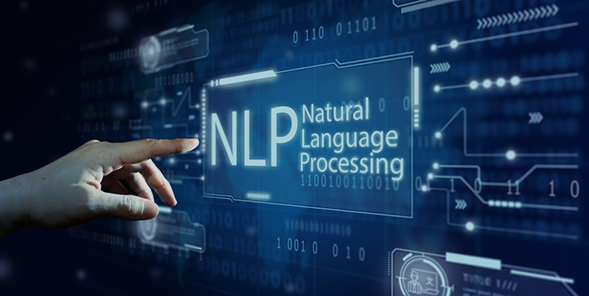


 SaaS Development
SaaS Development Web Application Development
Web Application Development Mobile Application Development
Mobile Application Development Custom Software Development
Custom Software Development Cloud Development
Cloud Development DevOps Development
DevOps Development MVP Development
MVP Development Digital Product Development
Digital Product Development Hire Chatbot Developers
Hire Chatbot Developers Hire Python Developers
Hire Python Developers Hire Django Developers
Hire Django Developers Hire ReactJS Developers
Hire ReactJS Developers Hire AngularJS Developers
Hire AngularJS Developers Hire VueJS Developers
Hire VueJS Developers Hire Full Stack Developers
Hire Full Stack Developers Hire Back End Developers
Hire Back End Developers Hire Front End Developers
Hire Front End Developers AI Healthcare Software Development & Consulting
AI Healthcare Software Development & Consulting Healthcare App Development
Healthcare App Development EHR Software Development
EHR Software Development Healthcare AI Chatbot Development
Healthcare AI Chatbot Development Telemedicine App Development Company
Telemedicine App Development Company Medical Billing Software Development
Medical Billing Software Development Fitness App Development
Fitness App Development RPM Software Development
RPM Software Development Medicine Delivery App Development
Medicine Delivery App Development Medical Device Software Development
Medical Device Software Development Patient Engagement Software Solutions
Patient Engagement Software Solutions Mental Health App Development
Mental Health App Development Healthcare IT Consulting
Healthcare IT Consulting Healthcare CRM Software Development
Healthcare CRM Software Development Healthcare IT Managed Services
Healthcare IT Managed Services Healthcare Software Testing services
Healthcare Software Testing services Medical Practice Management Software
Medical Practice Management Software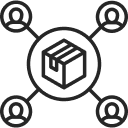 Outsourcing Healthcare IT Services
Outsourcing Healthcare IT Services IoT Solutions for Healthcare
IoT Solutions for Healthcare Medical Image Analysis Software Development Services
Medical Image Analysis Software Development Services Lending Software Development Services
Lending Software Development Services Payment Gateway Software Development
Payment Gateway Software Development Accounting Software Development
Accounting Software Development AI-Driven Banking App Development
AI-Driven Banking App Development Insurance Software Development
Insurance Software Development Finance Software Development
Finance Software Development Loan Management Software Development
Loan Management Software Development Decentralized Finance Development Services
Decentralized Finance Development Services eWallet App Development
eWallet App Development Payment App Development
Payment App Development Money Transfer App Development
Money Transfer App Development Mortgage Software Development
Mortgage Software Development Insurance Fraud Detection Software Development
Insurance Fraud Detection Software Development Wealth Management Software Development
Wealth Management Software Development Cryptocurrency Exchange Platform Development
Cryptocurrency Exchange Platform Development Neobank App Development
Neobank App Development Stock Trading App Development
Stock Trading App Development AML software Development
AML software Development Web3 Wallet Development
Web3 Wallet Development Robo-Advisor App Development
Robo-Advisor App Development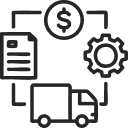 Supply Chain Management Software Development
Supply Chain Management Software Development Fleet Management Software Development
Fleet Management Software Development Warehouse Management Software Development
Warehouse Management Software Development LMS Development
LMS Development Education App Development
Education App Development Inventory Management Software Development
Inventory Management Software Development Property Management Software Development
Property Management Software Development Real Estate CRM Software Development
Real Estate CRM Software Development Real Estate Document Management Software
Real Estate Document Management Software Construction App Development
Construction App Development Construction ERP Software Development
Construction ERP Software Development





